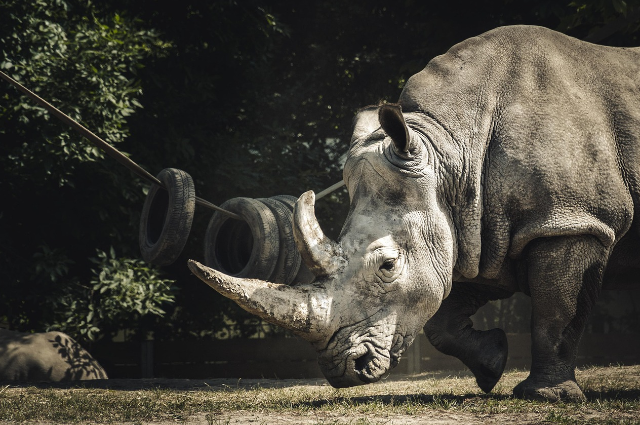
Alarming Rise in Human-Wildlife Conflict
A recent study conducted by the biodiversity conservation organization, Aaranyak, has brought to light a worrying increase in human-wildlife conflicts (HWC) in the Majuli River Island district of Assam. The findings indicate that incidents involving wild animals have grown more frequent compared to previous years, posing a significant challenge for local communities. The study highlights that animals such as rhinos, wild buffaloes, wild boars, elephants, and even tigers are responsible for damaging crops and livestock, leading to economic and safety concerns for the residents of the area.
Objective of the Study: Protecting Straying Rhinos
One of the primary goals of this six-day survey was to explore strategies for ensuring the safety of one-horned rhinos that have wandered onto the river island from Kaziranga National Park. The increasing movement of these rhinos into human settlements raises concerns about both the animals’ protection and the safety of the people living in the affected regions.
Engagement with Local Communities and Authorities
To gain a comprehensive understanding of the issue, the study involved interactions with over 110 households, local villagers, religious leaders known as Satradhikars (who head Vaishnavite monasteries), forest department officials, and law enforcement authorities. By consulting different stakeholders, the survey aimed to assess the intensity of the conflict and explore potential measures to mitigate the problem.
Survey Phases and Coverage Areas
The research was conducted in two major phases. The first three days focused on Namoni Majuli, which includes locations such as Sesuguri, Lobak Khutar, and Ahotoguri Island. In the second phase, the survey team shifted their attention to Ujoni Majuli, covering the region from Kamalabari Ghat to Gejera. This extensive fieldwork ensured a thorough assessment of the affected areas and provided valuable insights into the human-wildlife conflict situation across the island.
Research Team and Conservation Efforts
The survey was led by researchers Ujjal Bayan and Kakali Baishya, who are part of the Rhino Research and Conservation Division (RRCD) of Aaranyak. Their study aims to contribute to conservation strategies that not only safeguard wildlife but also address the concerns of local communities facing recurring conflicts with these animals.
The findings of this survey emphasize the urgent need for sustainable solutions to reduce human-wildlife conflict in Majuli River Island. Conservation efforts should focus on protecting both people and wildlife by implementing preventive measures, improving habitat management, and fostering community awareness. Collaborative efforts involving local residents, conservationists, and authorities will be crucial in ensuring a balanced coexistence between humans and wildlife in the region.
Majuli's Delicate Balance: Farming, Wildlife, and Hope for the Future
- A Look at the Challenges Faced by a Unique River Island: Recently, researchers Ujjal Bayan and Kakali Baishya, working with the Rhino Research and Conservation Division (RRCD) of Aaranyak, conducted a study on the island of Majuli. This study aimed to understand the complex relationship between the people living there and the wildlife that shares their home. What they found reveals a place of both challenges and remarkable natural beauty.
- The Struggle for Survival: Farming and Wildlife Conflicts: One of the biggest problems Majuli faces is the conflict between people and animals. Nearly 90% of the people living on the island depend on farming to make a living. When animals, like wild boars or deer, damage crops, it creates serious problems for these families. Their ability to feed themselves and earn money is directly threatened. This is a significant issue that needs urgent attention. To better understand these conflicts, the researchers spoke with local officials, including Range Officer Abhijit Dolley and Additional Superintendent of Police Bitul Chetia. They discussed how both humans and animals behave in these situations. This kind of understanding is crucial for finding solutions that work for everyone.
A Bright Spot: The Return of Migratory Birds
Despite the challenges, there's good news too. Majuli's wetlands are currently packed with migratory birds. This winter, many different bird species, such as glossy ibis, black-headed ibis, Indian spot-billed ducks, Greylag geese, bar-headed geese, and purple swamp hens, have arrived. They come to Majuli to rest, breed, and find food. This shows that the island is an important place for wildlife and has a rich and diverse ecosystem. It’s a sign that nature is still thriving on this unique river island.
Majuli is a special place, with its unique geography and environment. Because of this, it needs specific plans to address its problems. General solutions won't work. The island's challenges are tied to its specific situation.
The Path Forward: Protecting Both People and Nature
Aaranyak, the organization behind the research, believes that we need to find ways for people and wildlife to live together peacefully. This means creating strategies to reduce conflicts, teaching the community about the importance of conservation, and developing policies that support both the residents' livelihoods and the island's biodiversity.
In simple terms, we need to:
- Find ways to stop animals from damaging crops without harming them. This could involve building fences or using other methods to keep animals away.
- Teach people about the importance of protecting wildlife. This can help them understand why it's important to share their land with animals.
- Create rules and laws that help protect both people and animals. This could involve setting aside areas for wildlife or providing support to farmers who experience crop damage.
By taking these steps, we can help Majuli maintain its natural beauty and allow its residents to thrive. It's a matter of finding a balance that works for everyone.
. . .
References:
